Lamphey is a small village near the historic town of Pembroke, the birth place of Henry VII. The village itself includes an historic parish church and the Bishops Palace, the residence of the Bishops of St David’s. The men of the Parish of Lamphey are commemorated on a white marble War Memorial which is located inside the Parish Church of St. Tyfei. The memorial sadly does not contain the name of one Lamphey man, as he was executed for desertion during the war. He is among 306 British soldiers who were pardoned in August 2006, and so is included on this page.
The Great War, 1914-1918
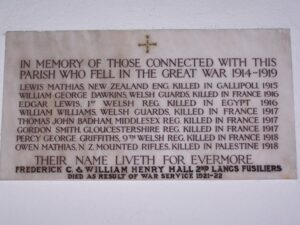
Thomas John Badham, Private, G/19411, Middlesex Regiment. Thomas was the son of Thomas and Ellen Badham, of 4, Station Terrace, Lamphey. He enlisted into the Army under the name of John Badham Thomas for some reason, which made finding his identity difficult. Thomas enlisted at Holloway, Middlesex, into the 1st Battalion, Middlesex Regiment. This was a regular battalion, and was attached to 19 Brigade after landing in France on 11 August 1914. The battalion then saw action during the retreat from Mons, and at First Ypres in 1914, and in 1915 at Neuve Chapelle and Loos. It fought on the Somme in 1916, before moving to Ypres in 1917, and it was here, during Third Ypres, that Thomas was mortally wounded. He was evacuated to the Casualty Clearing Station at Remy Sidings, where he died of his wounds on 26 September 1917. Thomas was 21 years old, and is buried at Lijssenthoek Military Cemetery, Belgium.
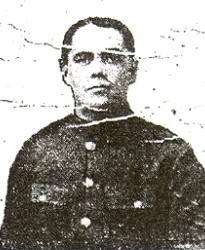
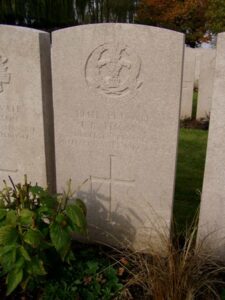
William George Dawkins, Private, 2120, Welsh Guards. William was born in 1889, the son of George and Elizabeth Dawkins, of Westhill Gate Cottage, Lamphey. He resided with his brother Albert at Penrhiwceiber prior to the war, and enlisted at Maesteg into the 1st Battalion, Welsh Guards, who had formed during February 1915, becoming attached to 3rd Guards Brigade, Guards Division. William joined the battalion in France at some time after the Battle of Loos, where the Welsh Guards suffered heavy casualties. He fought with them during the Battle of the Somme, and was killed on the Somme on 10 September 1916, aged 26. William has no known grave, and is commemorated on the Thiepval Memorial, France.
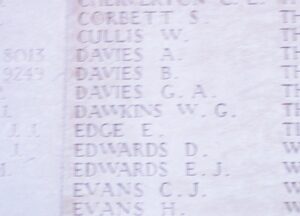
George Griffiths, Private, 203573, Welsh Regiment. George was the son of William and Martha Griffiths, of Portclew Lodge, Lamphey. He volunteered to serve in the Pembroke Yeomanry at the outbreak of war, and was given the service number 4750. After training, probably at Brecon, George was posted to the 9th Battalion, Welsh Regiment, which was in France as part of 58 Brigade, 19th (Western) Division. The Division had been on the Western front since the Battle of Loos in September 1915, and had forged a reputation for themselves after their excellent work at Loos and on the Somme in 1916. During 1917 the Division fought at the Battle of Messines, and at Third Ypres. In 1918 they were caught up in the German Spring Offensive near St. Quentin, where they suffered terrible casualties, and fought at the Battle of Bapaume. They moved to Ypres, but were caught up in the German attack at the Battle of the Lys. After suffering terribly again, they moved south to the quieter French sector to rebuild, but were caught up in the German offensive on the Aisne, and fought during the Battle of the Selle, and it was here that George was killed on 23 October 1918. He was 22 years old, and is commemorated on the Vis-En-Artois Memorial, France.
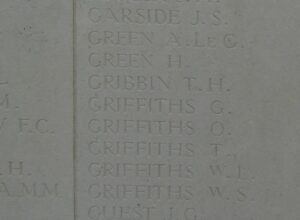
Frederick Charles Hall, Private, 3436975, Lancashire Fusiliers. Frederick was the son of William and Sarah Hall, of Lamphey. He originally enlisted into the Pembroke Yeomanry, with the service number 5472, but after training at Brecon, was posted to the 2nd Battalion, Lancashire Fusiliers, which was attached to 12 Brigade, 4th Division. The Division had fought on the Western front since the opening shots of the Battle of Mons. It had seen heavy fighting at Ypres and Arras, and in 1918 were in the centre of the fighting during the German Spring Offensive of 1918, and the subsequent Allied advance to victory. Frederick had suffered as a result of the war though. He returned home to Lamphey, only to die of wounds suffered during the war, on 25 March 1921. He was 25 years old, and is buried at Lamphey (St. Tyfei) Churchyard. In the same grave is buried his brother, William Hall. (see below).
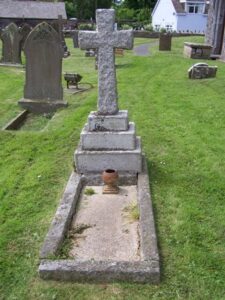
William Henry Hall, Private, 282289, Lancashire Fusiliers. William was the son of William and Sarah Hall, of Lamphey, and the brother of Frederick. He served with the 6th Battalion, Lancashire Fusiliers, which was attached to 197 Brigade, 66th Division. The Division had fought on the Western front from March 1917 onwards, and then fought at Third Ypres. Suring 1918 it suffered heavy casualties during the German Spring Offensive, before being withdrawn to rebuild, and taking part in the later Battle of Cambrai, and the Pursuit to the Selle and the Battle of the Selle. He survived the war, and lived at Brynglas, Twyn, Garnant after demobilisation. He married Modder Rees, of Garnant in 1922. William, like his brother Frederick, suffered terribly as a result of his war service, and died at home at Garnant on 28 September 1922. He is buried along with his brother at Lamphey (St. Tyfei) Churchyard.

William Hitchings, Petty Officer Stoker, 171271, Royal Navy. William was born at Lamphey on 26 February 1873. By 1891 he was working as a farm servant at Tenby, and on 10 January 1893 enlisted into the Royal Navy. By the outbreak of war, William was serving aboard H.M.S. Vanguard, a modern battleship, which was attached to the First Battle Squadron at Scapa Flow, and fought in the Battle of Jutland as part of the Fourth Battle Squadron. She was a part of the action from beginning to end, but did not suffer any damage or casualties. William took ill whilst at Scapa Flow, and died aboard the Hospital Ship Garth Castle of appendicitis and heart failure on 9 July 1916, aged 43. He is buried in Rosskeen Parish Churchyard Extension, Scotland. His next of kin was noted as his daughter, Winifred, of 20, Park Mead Rd, Wyles Regis, Nr Weymouth, Dorset. William is not commemorated locally. On 9 July 1917 Vanguard blew up whilst in anchor at Scapa Flow, with the loss of all aboard.
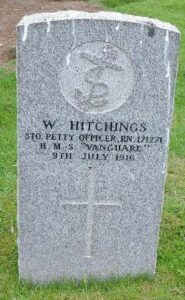
Edgar Lewis, Sergeant, 725073, Royal Field Artillery. Edgar was born in Monkton, the son of John and Margaret Lewis, of Rose Villa, Jameston, Manorbier. He enlisted at Neath into the 2nd (Glamorgan) Battery, 1st (Welch) Brigade, Royal Field Artillery, which served with the 53rd (Welsh) Division. Edgar served with the Division throughout their campaign on Gallipoli, and was with the Division in Egypt when he Died on the 23rd March 1917, aged 31. Edgar is buried at Alexandria (Hadra) War Memorial Cemetery, Egypt in Grave D. 93.
Lewis Mathias, Lance Corporal, 4/786, New Zealand Engineers. Lewis was born in New Zealand on 26 March 1887, the son of Lewis and Edith Caroline Mathias. The family resided at Timaru, New Zealand. Lewis enlisted at Waihola, New Zealand into the New Zealand Engineers. After training, he joined the 4th Reinforcements for the Engineers, and embarked on 17 April 1915 at Wellington aboard HMNZT Willochra, bound for Suez. By now the ANZAC’s had landed at Gallipoli on 25 April 1915, and Lewis was bound to join them on Gallipoli. Sadly, his war was not to last long, as Lewis became ill, and was evacuated to Mudros for treatment, but died on 21 July 1915. He is buried at East Mudros Military Cemetery, Greece.
Owen Mathias, Sergeant, 7/1319, New Zealand Infantry. Owen was born in New Zealand on 13 October 1888, the son of Lewis and Edith Caroline Mathias, of Timaru, New Zealand, and the brother of Lewis. He enlisted at Dargaville, New Zealand into the Canterbury Mounted Rifles, and after training embarked at Wellington aboard HMNZT Willochra, as part of the 6th Reinforcements, on 14 August 1915, to make up the battalion numbers after the fighting at Gallipoli. Owen served in the Palestinian campaign with the Mounted Rifles, and died of sickness there on 30 March 1918. He is buried at Damascus Commonwealth War Cemetery, Syria.
John Joseph Price, Private, 77449, Royal Welsh Fusiliers. John was born in 1899, the son of John and Sarah Price, of Bridge End Place, Aberystwyth. He resided at Lamphey prior to the war, and enlisted at Carmarthen into the army. John was sent to France at some time during 1918, where he joined the 16th Battalion, Royal Welsh Fusiliers. The battalion was attached to 113 Brigade, 38th (Welsh) Division, and John probably joined them on the Somme, at Aveluy. On 21 August 1918 the Division launched its attack across the River Ancre, and within days captured Thiepval Ridge and Pozieres. They then began their drive towards the Hindenburg Line. John was killed in action during the Battle of the Selle, on 22 October 1918. He is buried at Montay Communal Cemetery, France. John is not commemorated at Lamphey or Aberystwyth.
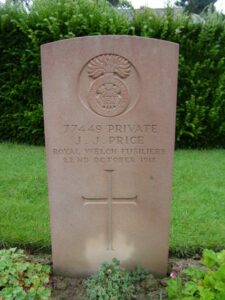
Robert Rossiter, Private, 23628, Welsh Regiment. Robert was born at Lamphey, the son of Warlow and Mary Rossiter. The family later moved to Lower Law’s Street, Pembroke Dock. Robert married Margaret Ellen Griffiths at Bridgend in December 1914, probably just after he had enlisted into the Rhondda Battalion, Welsh Regiment. Robert was one of 200 Rhondda men posted to the 15th Welsh, the Carmarthen Pals Battalion. The Battalion was attached to 114 Brigade, 38th (Welsh) Division, and moved to France in December 1915, being sent to the line at Fleurbaix. In June 1916 the Welsh marched to the Somme, and fought at Mametz Wood. After being decimated at Mametz, they moved to Ypres, where they took the line at Boesinghe. The Division fought during the opening assault of the Battle of Pilckem Ridge on 31 July 1917, and the 15th Welsh remained in the area to aid the 20th Division in their advance to Langemarck. Robert was killed here on 8 September 1917. He was 35 years old, and is commemorated on the Tyne Cot Memorial, Belgium. Robert is not commemorated at Lamphey.
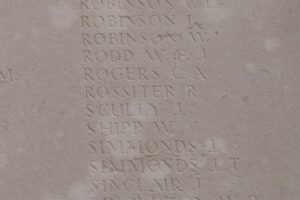
Alfred Gordon Smith, Private, 18850, Gloucestershire Regiment. Gordon was the son of Squadron Sergeant Major James Smith, Pembroke Yeomanry, and of Amelia Smith, of Hodgeston, Lamphey. He enlisted at Haverfordwest into the Army, and was posted to the 12th Battalion, Gloucestershire Regiment, which was attached to 95 Brigade, 32nd Division. At the end of December 1915 the Division was in France, and the following year took part in the opening of the Somme Offensive, fighting at the Battle of Albert, the Battle of Bazentin, the Battle of the Ancre and the resulting Operations on the Ancre. They remained here over the winter, and in March 1917 followed the German Retreat to the Hindenburg Line. Gordon was killed in action here on 8 May 1917, aged 20. Gordon has no known grave, and is commemorated on the Arras Memorial, France.
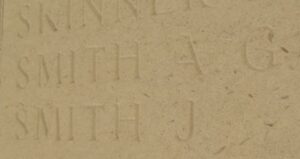
John Thomas, Private, 12727, Welsh Regiment. John was the son of Mrs. M. Davies, of Lamphey, and was a married man with three children. He was an old soldier, having been placed on the reserve list at some time leading up to the war, and was one of many middle aged men recalled to the colours at the outbreak of war, joining the 2nd Battalion, Welsh Regiment. John landed in France on 3 February 1915, and joined the battalion in Flanders. He saw action At Neuve Chapelle and Second Ypres, but had become disenchanted by military life at the end of 1915. John was among a group of men who were almost twice the age of the majority of the soldiers in the BEF, and thought that he should have been given a job behind the lines. John then deserted on 17 May 1916, but was caught and returned to his unit, where he was to be made an example of. John was executed for desertion at Mazingarbe on 20 May 1916. The Court was unsympathetic to his age, and showed no mercy. He was 44 years old, and is buried at Mazingarbe Military Cemetery. John had been the first of two Pembroke men to be shot at dawn during the Great War. In August 2006, John was among the list of 306 soldiers who were shot at who received an official pardon from the British Government, thus clearing his name. He is not commemorated on the Lamphey War Memorial, probably as he was a shot at dawn case, but now that he has been given this pardon, John should be commemorated with honour alongside his fellow Lamphey men.
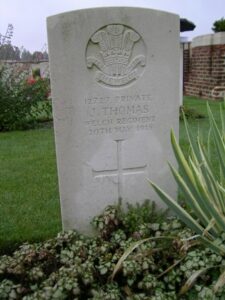
William Williams, Private, 2779, Welsh Guards. William was the son of William and Ann Williams, of Lamphey, and prior to the war worked with Mr. Hier, Coke and Coal Merchant. In February 1915, a Regiment of Welsh Guards was raised, and William enlisted into this new Regiment of Guards. He was posted to the Western front after his training, and joined the 1st Battalion, Welsh Guards, which was attached to 3rd Guards Brigade, Guards Division. He joined the Guards after the fighting at Loos in September 1915, probably as a reinforcement after the Somme Battles in 1916, where the Guards took heavy casualties at Ginchy and Combles. The Guards then moved to Belgium, and William was killed during the Third Battle of Ypres on 9 October 1917, aged 32. He is buried at Solferino Farm Cemetery, Belgium.
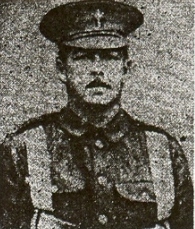
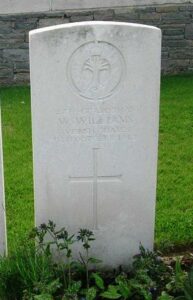
World War Two, 1939-1945
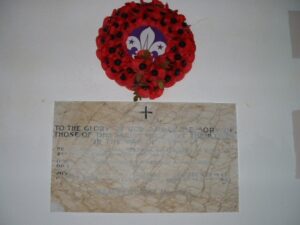
Ivor Mornington Bowen, Civilian. Ivor was the son of James and Sarah Bowen, of Post Office, Lamphey. He married Eileen Marjorie Sewell at Uxbridge in 1934, and the couple resided at 42, Bush Grove, Stanmore, Harrow, where Ivor worked for the Post Office. Ivor was 33 years old when he was killed whilst walking home during an Air Raid at the junction of Whitechurch Lane and Edgware Road on 16 September 1940. He is buried in Little Stanmore, London.
Anthony Ronald Mathias, Pilot Officer (Pilot), 41603, Royal Air Force. Anthony was born on 23 January 1920, the son of Charles Ronald and Shelagh Mathias, of Lamphey. He served as a Pilot with 500 Squadron, Royal Air Force, which was a Coastal Command Squadron, equipped with the Avro Anson. Anthony was shot down while on a patrol over the English Channel on 11 July 1940, and was killed along with his Wireless Operator, William Charles Hubbard. Anthony is buried at Rotterdam (Crooswjik) General Cemetery, Netherlands.
Phyllis Mildred Mathias, S.C.M.M.G., L.E.T., M.E., Civilian. Phyllis was the daughter of Alice Sidney Evelyn Henwood, and Mildred Henwood (nee White), of Entabeni, Vryheid, Natal, South Africa, and was a qualified masseuse. She had married Wing Commander Lewis Mathias, R.A.F., at Lamphey Court on 9 October 1942, where the couple set up home. On 23 November 1942 Phyllis boarded the White Star Liner SS Ceramic, along with her friend Mabel Burgess Nicholas. Ceramic was bound for Durban, and held 378 passengers. Phyllis was presumably going to visit her family in South Africa. On the night 6 December 1942, Ceramic was attacked and torpedoed by the German Submarine U-515, with the loss of 655 lives. Phyllis was 31 years old when she died that night, and is commemorated upon the S.S. Ceramic Memorial.